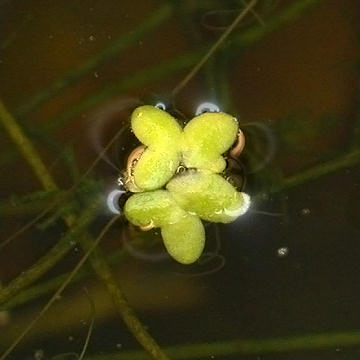

Lemna minor - (image 1 of 3)
Taxonomy
Family: Lemnaceae
Habitat
Ponds, shallow water of lakes, slow moving streams and rivers, ditches.
Associates
Distribution
Widespread; nearly cosmopolitan.
Morphology
Fronds without proximal papules, or with papules smaller than the distal ones, rotund or elliptic or obovate, nearly symmetrical, mostly more than 1.5 mm wide, often in groups of 2-5, often with reddish punctae (spots) or tinges below and green above or anthocyanic on both sides, flat to slightly concave on both sides, with 2-4 lateral nerves; air spaces in fronds less than 0.3 mm in diameter; roots mostly more than 3 cm long with blunt tips. Spathes sac-like, open at the top only. Fruit not winged; seeds solitary, smooth or inconspicuously ribbed.
Notes
Flowers July to September.
Wetland indicator: Obligate
The body of a duckweed may be referred to as a frond or as a thallus. Flowers not often observed. Spreads rapidly by division.
References
Gleason, Henry A.
and A. Cronquist. 1991. Manual of Vascular Plants of Northeastern United States
and Adjacent Canada. Second Ed.
The New York Botanical Garden. Bronx, NY.
Swink, F. and G.
Wilhelm. 1994. Plants of the Chicago Region.
Indiana Academy of Science. The Morton Arboretum. Lisle, Illinois.
|
Michael Hough © 2010 |